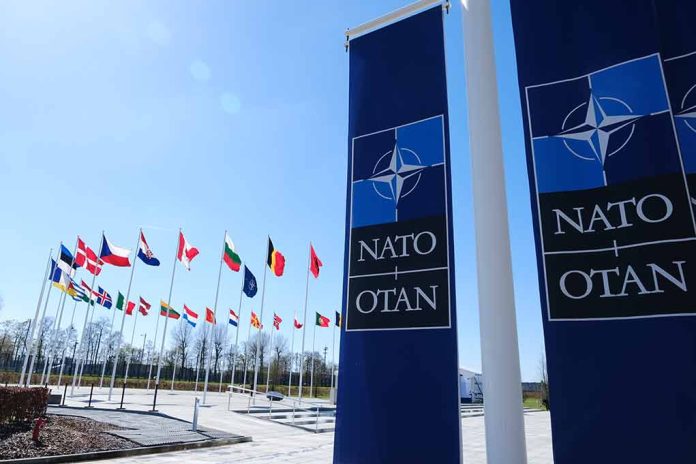
Russia’s new Oreshnik missile system introduces significant challenges to NATO’s operational readiness and regional security, altering the dynamics of military strategy and conflict scenarios.
Key Takeaways
- Russia used its hypersonic Oreshnik missile for the first time in an attack on a military facility in Dnipro, Ukraine.
- The missile travels at Mach 10, potentially reaching Mach 11, and is claimed to be immune to missile defense systems.
- The Oreshnik can carry nuclear or conventional warheads, with a range that can reach any European target.
- Putin described the missile as a response to Western countries allowing Ukraine to use longer-range weapons.
- The missile attack marked the first use of such a weapon in war, with a range of 500 to 5,500 kilometers.
The First Offensive Use of Oreshnik
The Oreshnik missile was first deployed by Russia in an attack on a military site in Dnipro, Ukraine, on November 21. This medium-range ballistic missile has intensified NATO’s concerns about regional security. The introduction of the Oreshnik exemplifies Russia’s strategy to reduce its reliance on nuclear capabilities while still maintaining a threatening stance against the West through conventional means.
The missile can carry either conventional or nuclear warheads, significantly elevating its threat level. Travelling at speeds of Mach 10, it presents a formidable challenge to existing missile defense systems in Europe.
🇷🇺🚀💥🏴☠️🇺🇦 ⚔️#Russia #Россия #Putin #Kremlin #Орешник #Oreshnik #Oreshnikmissile #Russiannuclear #Ukraine #NATO #EU #US #UK: (ENGLISH VOICED): Russia will continue testing the newest missile system Oreshnik! Putin
The new Russian missile Oreshnik can hit targets throughout… pic.twitter.com/MYikszgbJX— 🌐World News 24 🌍🌎🌏 (@DailyWorld24) November 24, 2024
Strategic Implications for NATO
The Oreshnik’s capability to bypass defense systems and threaten extensive European targets demands urgent attention from NATO. Analysts suggest that current defenses in Europe are inadequate against such threats. Proper strategic responses may include dispersing NATO’s aircraft across various locations to minimize targeted vulnerabilities, as highlighted by Decker Eveleth.
“Modern fighter jets—the F-35, which many NATO nations are increasingly using—are too complex to be field repaired.” said CNA analyst Decker Eveleth.
The potential deployment of the Oreshnik in Belarus by 2025 further underscores Russia’s intentions to expand its influence. Additionally, with plans to increase production facilities, Russia aims at having a more substantial conventional arsenal.
🇷🇺VLADIMIR PUTIN:
"I would like to inform the military personnel of the Russian Federation Armed Forces, citizens of our country, our friends across the globe, and those who persist in the illusion that a strategic defeat can be inflicted upon Russia.
This concerns the events… pic.twitter.com/P3UmkR80jE
— Sony Thang (@nxt888) November 22, 2024
Psychological Warfare and Regional Politics
By using Oreshnik against Ukraine, Russia showcases both its military might and tactical acuity, challenging Western alliances to devise effective countermeasures. This development is being viewed as not only a military threat but also a tool for psychological warfare aimed to instill deterrence and fear in Western countries. Putin has even claimed the weapon is powerful enough that it could destroy underground bunkers “three, four or more floors down.”
The missile launch has undoubtedly escalated East-West tensions. The implications of Russia’s evolving missile technology inevitably call for NATO to reassess and fortify its strategic military posture within Europe, ensuring its operational readiness against potential future conflicts.
Sources:
- https://www.ap.org/news-highlights/spotlights/2024/russia-has-used-its-hypersonic-oreshnik-missile-for-the-first-time-what-are-its-capabilities/
- https://apnews.com/article/russia-ukraine-intercontinental-missile-war-putin-d50183ccfc28b10c71e93f3e68159a61
- https://rmx.news/russia/military-expert-says-putins-new-weapon-is-bad-news-for-nato/
- https://foreignpolicy.com/2025/03/17/russia-missile-nato-oreshnik-ukraine-war-conventional-weapons/










